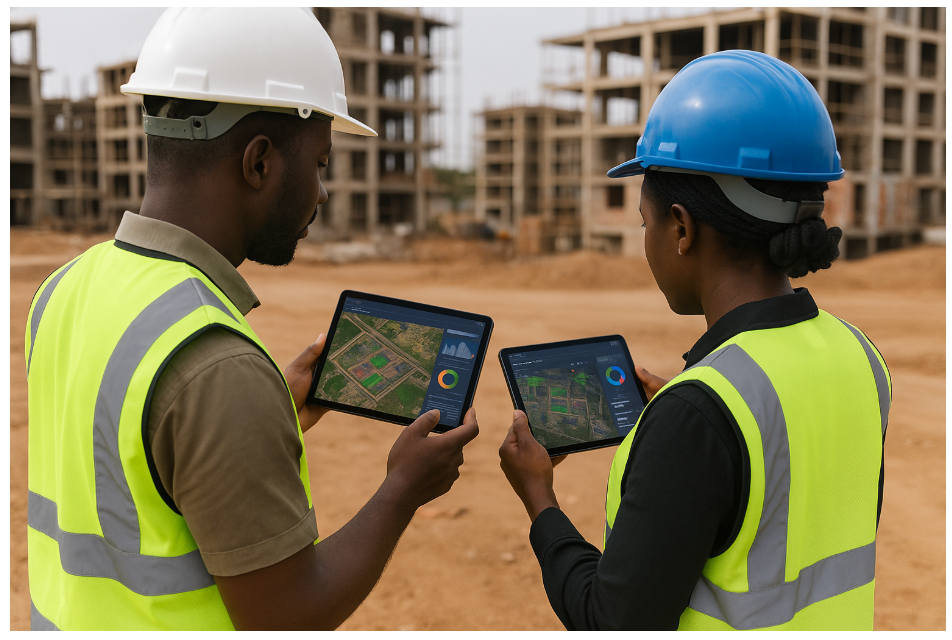Construction Progress Tracking: Spreadsheet vs Drone-Based Software
If you’ve ever managed a large construction project, you’ve probably relied on spreadsheets to keep things organized. Tasks, materials, labor schedules, all tracked in cells and rows. But over time, you realize something: the bigger the project, the less that spreadsheet can tell you.
We once worked with a team managing a multimillion-dollar build across several regions. They tracked everything using Excel. But when we flew a drone over the site, it revealed something the spreadsheet didn’t: an entire section of foundation was misaligned by meters. That discovery saved weeks of costly rework and exposed the blind spots in manual tracking.
Spreadsheets feel familiar, but their limitations surface fast when things get complex. In this post, we’ll explore why drone-based progress tracking platforms like Charis Analytics are replacing outdated tools and how construction companies across Africa are gaining real-time visibility that spreadsheets simply can’t provide.
The Spreadsheet Struggle on Big Projects

On paper (or screen), spreadsheets seem like a simple solution. Many construction teams start with Excel or Google Sheets to track progress. However, on large projects, the limitations of spreadsheets become evident. Here are the key weaknesses holding your projects back:
Prone to Human Error
Spreadsheets rely on manual data entry and formula management. One copy-paste mistake or a mistyped number can cascade into costly errors. High-profile fiascos (like a $6 billion trading loss from a bad Excel formula) highlight this risk.
No Visual or Geospatial Context
Rows and columns can’t show you what’s actually happening on site. You can’t look at an Excel cell and see a cracked foundation or a half-finished roof. There’s no map, no 3D model, no photo, just numbers that represent reality. A drone photo could reveal a huge unexcavated section that text alone hid. Traditional tracking leaves you essentially blind to on-site conditions.
Delayed, Out-of-Date Information
Spreadsheets are usually updated after-the-fact. Team members in the field take notes or measurements, then at day’s end someone manually inputs the data. By the time that spreadsheet circulates (often via long email threads), the project has moved on.
Poor Integration & Analytics
Ever try linking a spreadsheet to your scheduling software or BIM model? It’s a manual, headache-inducing process. Spreadsheets don’t integrate well with other tools, forcing extra data entry and extraction. They also offer limited automation or analytics – no automatic progress reports, no AI insights.
In summary, relying on spreadsheets is like driving a car by looking through the rear-view mirror. You see some of what happened after it happened, and you hope no mistakes were hiding in your blind spots.
The Drone-Based Construction Solution: Real-Time Eyes on Your Site

It’s not all doom and gloom – modern technology offers a way out of the spreadsheet trap. Drone-based project tracking platforms (such as Charis Analytics) are giving African construction teams a real-time, bird’s-eye view of their projects. Imagine being able to oversee multiple sites as if you’re there on the ground 24/7, without leaving your office. That’s the promise of drone-driven progress tracking.
How does it work?
Drones automatically capture high-resolution aerial images, videos, and LiDAR scans of your site on a regular schedule. That data streams into a cloud platform (like Charis Analytics), which processes it into maps, 3D models, and actionable insights. The platform then gives you a dashboard of your project’s current status, accessible to all stakeholders in real time. Essentially, you get live, visual “spreadsheets” of your site that update themselves.
Here are some of the game-changing benefits of drone-based software:
Live Visual Monitoring
Instead of static charts, you have up-to-date aerial maps and 3D models. You can log in and literally see the progress – what was done today, what’s changed since last week, etc. With Charis Analytics, you gain real-time virtual control over your site, as if physically present 24/7.
AI-Driven Issue Detection
Advanced drone platforms leverage artificial intelligence to compare each new dataset to your project plans. If something’s off – say the excavation is behind schedule, or a wall is built where it shouldn’t be – the system flags it automatically. AI-enabled drones can highlight discrepancies and deviations by comparing current site data with the plan. In other words, the software “watches” for you.
Collaborative, Single Source of Truth
A drone-based platform becomes a central hub for all project data – one that everyone accesses. No more emailing version 17 of an Excel file or wondering if someone updated the sheet. Every stakeholder sees the same updated information live, whether they’re on site or in the head office. This improves communication and transparency dramatically. Charis Analytics, for example, helps improve communication across teams and reduce confusion and rework.
Comprehensive Records & Analytics
All that rich visual and numeric data collected over time is stored and readily accessible. Drone software can produce digital records and proof of progress, which helps avoid disputes and speed up client sign-offs. Plus, you can analyze trends: how fast is each stage being built versus the plan, where are the frequent delays, etc. These analytics go far beyond what a basic spreadsheet can do. They give you insights to continuously improve your project delivery and predict issues before they happen.
Conclusion: It’s Time to Optimize Your Progress Tracking
The construction industry in Africa is booming – but if you’re still managing that boom with 20th-century tools like Excel, you’re holding yourself back. The limitations of spreadsheets (human error, lack of visuals, slow updates) quietly drain money and time from your projects.
Adopting drone-based progress tracking is easier and more affordable than ever. You don’t need to be a tech giant to leverage it – companies like Charis Analytics are making these tools accessible to construction teams across Africa.
Ready to get started? Take that step – explore solutions like Charis Analytics, ask for a demo, or book a consultation to see the technology in action. It’s time to elevate your project tracking from a scattered spreadsheet to a smart, cloud-based command center.

